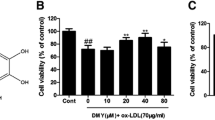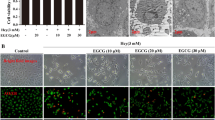Abstract
Coronary artery disease is a disease with high morbidity and mortality, in which vascular endothelial dysfunction plays an important role. Hypoxia leads to the inflammation and oxidative stress in endothelial cells, which results in the endothelial injury. The present study was designed to investigate the protective effect and mechanism of folic acid on hypoxia-induced injury in human umbilical vein endothelial cells (HUVEC). Cell counting Kit was used to detect cell survival rate, and apoptotic cells were detected by Hoechst 33258 staining. Intracellular reactive oxygen species (ROS) level was measured using dichloro-dihydro-fluorescein diacetate staining. Western blot was used to determine the protein expressions of extracellular signal protein kinase 1/2 (ERK1/2) and phosphorylated ERK1/2 (p-ERK1/2), NOX4 subunit of NAPDH and endothelial nitric oxide synthase (eNOS). Folic acid significantly increased the cell survival rate and decreased the apoptosis of HUVECs treated with folic acid compared with hypoxia-treated HUVEC. Folic acid also decreased ROS level, while it increased the nitrite content in HUVECs. In addition, folic acid decreased protein expressions of NOX4 and p-ERK1/2, while it increased the protein expression of eNOS in HUVECs. Furthermore, N-acetyl cysteine (NAC), the antioxidant, had similar effect on the cell survival rate and the apoptosis. In addition, DPI (NOX4 inhibitor) and U0126 (ERK1/2 inhibitor) rather than NAC decreased the protein expression of NOX4. NAC, DPI, and U0126 increased the protein expression of eNOS. Furthermore, U0126 rather than DPI and NAC decreased the protein expression of p-ERK1/2. Taken together, the results suggested that hypoxia decreased the cell survival rate and induced apoptosis via ERK1/2/NOX4/ROS pathway, which could be the target of folic acid in protecting the HUVECs from injury caused by hypoxia.




Similar content being viewed by others
References
Wang, J. M., Yang, Z., Xu, M. G., Chen, L., Wang, Y., Su, C., & Tao, J. (2009). Berberine-induced decline in circulating CD31+/CD42− microparticles is associated with improvement of endothelial function in humans. European Journal of Pharmacology, 614, 77–83.
Ganz, P., & Hsue, P. Y. (2013). Endothelial dysfunction in coronary heart disease is more than a systemic process. European Heart Journal, 34, 2025–2027.
Gutierrez, E., Flammer, A. J., Lerman, L. O., Elizaga, J., Lerman, A., & Fernandez-Aviles, F. (2013). Endothelial dysfunction over the course of coronary artery disease. European Heart Journal, 34, 3175–3181.
Imamura, A., Murakami, R., Takahashi, R., Cheng, X. W., Numaguchi, Y., Murohara, T., & Okumura, K. (2010). Low folate levels may be an atherogenic factor regardless of homocysteine levels in young healthy nonsmokers. Metabolism, 59, 728–733.
Galkin, A., Higgs, A., & Moncada, S. (2007). Nitric oxide and hypoxia. Essays in Biochemistry, 43, 29–42.
Ho, J. J., Man, H. S., & Marsden, P. A. (2012). Nitric oxide signaling in hypoxia. Journal of Molecular Medicine (Berl), 90, 217–231.
Kondoh, M., Ohga, N., Akiyama, K., Hida, Y., Maishi, N., Towfik, A. M., et al. (2013). Hypoxia-induced reactive oxygen species cause chromosomal abnormalities in endothelial cells in the tumor microenvironment. PLoS One, 8, e80349.
Moon, E. J., Sonveaux, P., Porporato, P. E., Danhier, P., Gallez, B., Batinic-Haberle, I., et al. (2010). NADPH oxidase-mediated reactive oxygen species production activates hypoxia-inducible factor-1 (HIF-1) via the ERK pathway after hyperthermia treatment. Proceedings of the National Academy Sciences of United States of America, 107, 20477–20482.
Tang, F., Chan, E., Lu, M., Zhang, X., Dai, C., Mei, M., et al. (2015). Calpain-1 mediated disorder of pyrophosphate metabolism contributes to vascular calcification induced by oxLDL. PLoS One, 10, e0129128.
Goettsch, C., Goettsch, W., Muller, G., Seebach, J., Schnittler, H. J., & Morawietz, H. (2009). Nox4 overexpression activates reactive oxygen species and p38 MAPK in human endothelial cells. Biochemical and Biophysical Research Communications, 380, 355–360.
Zoungas, S., Branley, P., Kerr, P. G., Ristevski, S., Muske, C., Demos, L., et al. (2004). Atherosclerosis and folic acid supplementation trial in chronic renal failure: baseline results. Nephrology (Carlton), 9, 130–141.
Moat, S. J., Clarke, Z. L., Madhavan, A. K., Lewis, M. J., & Lang, D. (2006). Folic acid reverses endothelial dysfunction induced by inhibition of tetrahydrobiopterin biosynthesis. European Journal of Pharmacology, 530, 250–258.
Miao, Y., Zhang, Y., Lim, P. S., Kanjanapan, Y., Mori, T. A., Croft, K. D., et al. (2007). Folic acid prevents and partially reverses glucocorticoid-induced hypertension in the rat. American Journal of Hypertension, 20, 304–310.
Moat, S. J., Madhavan, A., Taylor, S. Y., Payne, N., Allen, R. H., Stabler, S. P., et al. (2006). High- but not low-dose folic acid improves endothelial function in coronary artery disease. European Journal of Clinical Investigation, 36, 850–859.
Eguchi, R., Suzuki, A., Miyakaze, S., Kaji, K., & Ohta, T. (2007). Hypoxia induces apoptosis of HUVECs in an in vitro capillary model by activating proapoptotic signal p38 through suppression of ERK1/2. Cellular Signalling, 19, 1121–1131.
Chen, B., Zhao, Q., Ni, R., Tang, F., Shan, L., Cepinskas, I., et al. (2014). Inhibition of calpain reduces oxidative stress and attenuates endothelial dysfunction in diabetes. Cardiovascular Diabetology, 13, 88.
Kase, H., Hashikabe, Y., Uchida, K., Nakanishi, N., & Hattori, Y. (2005). Supplementation with tetrahydrobiopterin prevents the cardiovascular effects of angiotensin II-induced oxidative and nitrosative stress. Journal of Hypertension, 23, 1375–1382.
Antoniades, C., Shirodaria, C., Warrick, N., Cai, S., de Bono, J., Lee, J., et al. (2006). 5-methyltetrahydrofolate rapidly improves endothelial function and decreases superoxide production in human vessels: effects on vascular tetrahydrobiopterin availability and endothelial nitric oxide synthase coupling. Circulation, 114, 1193–1201.
Hung, M. W., Kravtsov, G. M., Lau, C. F., Poon, A. M., Tipoe, G. L., & Fung, M. L. (2013). Melatonin ameliorates endothelial dysfunction, vascular inflammation, and systemic hypertension in rats with chronic intermittent hypoxia. Journal of Pineal Research, 55, 247–256.
Liu, X., Deng, Y., Shang, J., Yang, X. H., Liu, K., Liu, H. G., & Xu, Y. J. (2013). Effect of NADPH oxidase inhibitor apocynin on the expression of hypoxia-induced factor-1 alpha and endothelin-1 in rat carotid body exposed to chronic intermittent hypoxia. Journal of Huazhong University of Science and Technology Medical Science, 33, 178–184.
Yeo, J. E., Kim, J. H., & Kang, S. K. (2008). Selenium attenuates ROS-mediated apoptotic cell death of injured spinal cord through prevention of mitochondria dysfunction; in vitro and in vivo study. Cellular Physiology and Biochemistry, 21, 225–238.
Austen, S. K., Fassett, R. G., Geraghty, D. P., & Coombes, J. S. (2006). Folate supplementation fails to affect vascular function and carotid artery intima media thickness in cyclosporin A-treated renal transplant recipients. Clinical Nephrology, 66, 373–379.
Bleie, O., Semb, A. G., Grundt, H., Nordrehaug, J. E., Vollset, S. E., Ueland, P. M., et al. (2007). Homocysteine-lowering therapy does not affect inflammatory markers of atherosclerosis in patients with stable coronary artery disease. Journal of Internal Medicine, 262, 244–253.
Shirodaria, C., Antoniades, C., Lee, J., Jackson, C. E., Robson, M. D., Francis, J. M., et al. (2007). Global improvement of vascular function and redox state with low-dose folic acid: Implications for folate therapy in patients with coronary artery disease. Circulation, 115, 2262–2270.
Maier, W., Cosentino, F., Lutolf, R. B., Fleisch, M., Seiler, C., Hess, O. M., et al. (2000). Tetrahydrobiopterin improves endothelial function in patients with coronary artery disease. Journal of Cardiovascular Pharmacology, 35, 173–178.
Guo, H., Chi, J., Xing, Y., & Wang, P. (2009). Influence of folic acid on plasma homocysteine levels & arterial endothelial function in patients with unstable angina. Indian Journal of Medical Research, 129, 279–284.
McCarty, M. F. (2004). Coping with endothelial superoxide: potential complementarity of arginine and high-dose folate. Medical Hypotheses, 63, 709–718.
Acknowledgments
This study was supported by Science and Technology Planning Project of Guangdong Province, China (2011B031800011).
Author information
Authors and Affiliations
Corresponding author
Ethics declarations
Conflict of interest
None.
Rights and permissions
About this article
Cite this article
Cheng, F., Lan, J., Xia, W. et al. Folic Acid Attenuates Vascular Endothelial Cell Injury Caused by Hypoxia via the Inhibition of ERK1/2/NOX4/ROS Pathway. Cell Biochem Biophys 74, 205–211 (2016). https://doi.org/10.1007/s12013-016-0723-z
Received:
Accepted:
Published:
Issue Date:
DOI: https://doi.org/10.1007/s12013-016-0723-z




